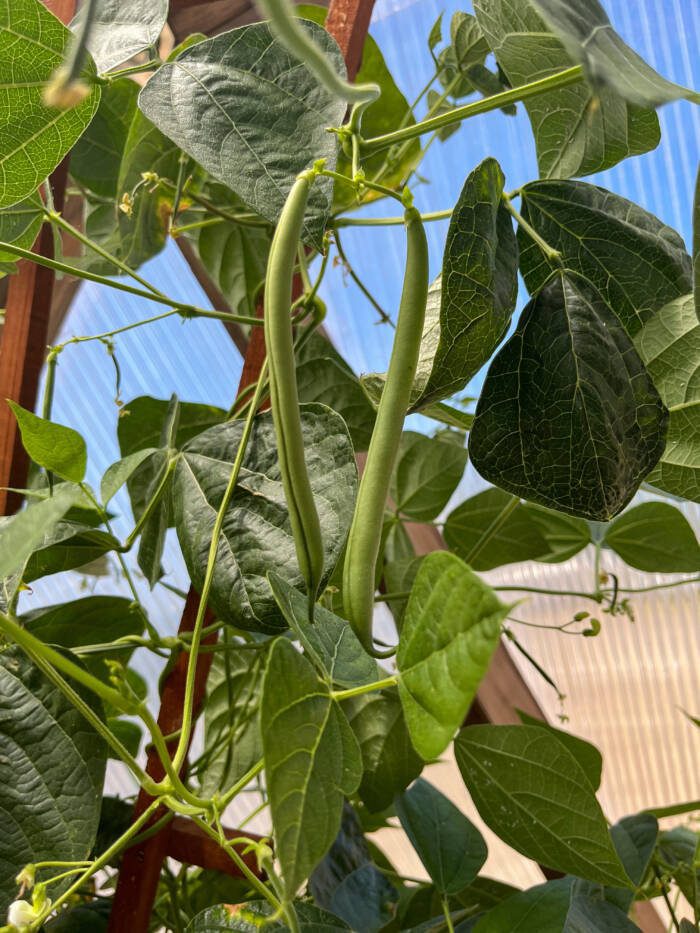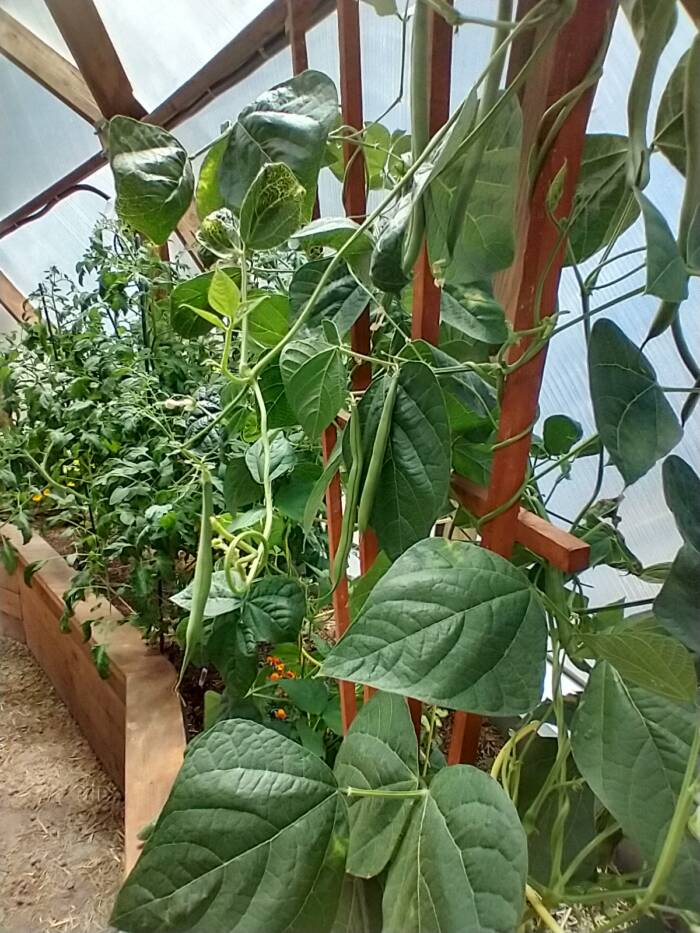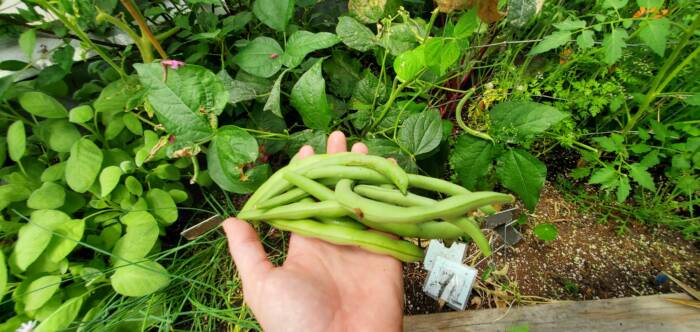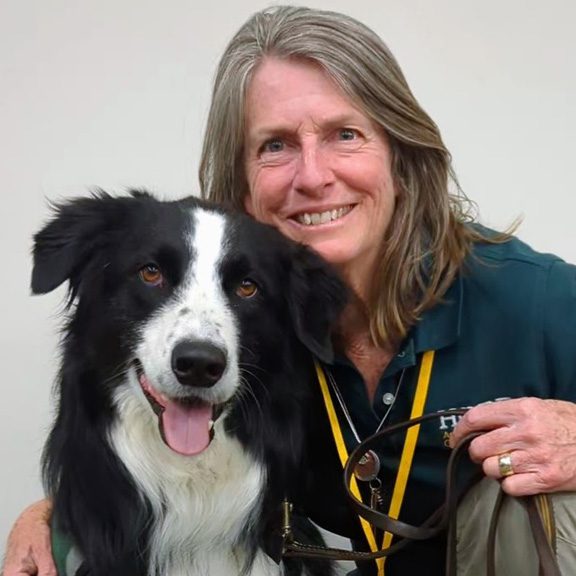Featured Plant of the Month: Beans!
Jump to: Growing Beans – Cultivation Tips, Bean Companion Plants, How to Harvest Beans.
Bean History – Know Before You Grow
Common (green) beans, scientifically known as Phaseolus vulgaris, originate from South America and Central America. Historical evidence suggests beans were cultivated in Mexico and Peru for millennia. They were later introduced to the Mediterranean by Christopher Columbus in 1492 and became prevalent in Italy, Greece, and Turkey by the 17th century.

One of the earliest instances of companion planting is found in Native American agricultural practices, where they grew beans, corn, and squash together in a mutually beneficial relationship known as the “Three Sisters” or “De-o-ha-ko,” meaning “our sustainers” or “those who support us.” This practice was mainly adopted by the Iroquois in the northeastern regions of the US and Canada.
Beans are classified into two categories: Bush beans and Pole beans. Bush beans are compact, reaching about 2 feet in height, and do not require a trellis. On the other hand, Pole beans, or climbing beans, are vines that can grow 10 to 15 feet tall and need trellises or stakes for support.
In addition to their health benefits, beans are easy to grow and a great source of fiber, vitamin C, beta-carotene, folate, potassium, and protein, according to the American Heart Association. They are a fantastic addition to any garden due to their positive impact on both our health and the garden’s well-being.
Beans are legumes and possess nitrogen-fixing abilities. Specific bacteria colonize their roots, extracting nitrogen from the air and converting it into a form that nourishes the plant—a truly remarkable process I wish we could replicate ourselves!
Easy Cultivation Tips for Growing Beans (Bush & Pole)
Beans are incredibly easy to grow, making them a favorite choice for new gardeners and even children. These annual plants grow rapidly, and the ideal time to plant them is in the spring. To thrive, beans prefer well-drained, loamy soil with a slightly acidic to neutral pH ranging from 6.0 to 7.0. Additionally, they require a sunny location, basking in 6-8 hours of sunlight per day.
One fantastic aspect of beans is their natural ability to fix nitrogen in the soil, which often eliminates the need for fertilizers unless the soil quality is poor.

As mentioned above, there are two main categories of beans. Pole beans are the tallest, reaching heights of 2′-15′, and they require trellising or staking for support. On the other hand, bush beans are more compact, growing to about 2′-3′ wide, and need less maintenance. Bush beans typically produce a full harvest within 50-55 days, so staggering plantings can ensure a continuous harvest. In contrast, pole beans produce a higher yield over an extended period due to the time required for the vines to develop. Generally, the first harvest of pole beans is ready in 55-65 days.
For successful growth, it’s best to directly sow bean seeds, as their delicate roots don’t tolerate transplanting well. Plant the seeds at a depth of 1″, and if you are growing pole beans, consider placing them near a trellis. To maintain moisture, especially for outdoor plantings, provide the beans with approximately 1″ of rain per week and use mulch, as their shallow roots benefit from retaining moisture.
As pole beans grow, once they reach the top of the trellis, pinch off the tops. This encourages the plant to focus its energy on producing pods, leading to a bountiful harvest.
Green Beans Fun Facts
- Green beans are the third favorite vegetable that home gardeners grow (after tomatoes and peppers).
- Did you know that there are about 130 types of beans? They are green, purple, yellow, red and spotted.
- Wisconsin is at the top of the beanstalk for growing the most green beans in the US with over 1/3 of all green beans grown in the country. It’s not just about cheese in Wisconsin!
- Do you know what kind of shows beans do…Podcasts! Their favorite movie is Pirates of the Caribbean!
- Beans are deeply rooted (pun intended) in our culture and the proof is in how often the word “bean” is used! Bean is a common nickname. Do you wear a beanie in the winter? Then there are the sayings: “Don’t spill the beans!” or “Skinny as a stringbean!” and our personal favorite “Cool beans!” pioneered by Cheech & Chong, but popularized on the TV show Full House.
- Did you know there was a famous musician nicknamed “Stringbean”? David “Stringbean” Akemon played banjo at the Grand Ole Opry and was a main character on the TV show HeeHaw.

Growing Beans – Companion Plants
As mentioned in past featured plant blogs, companion planting involves selecting plants that benefit each other. This can be through nutrient addition to the soil, attracting beneficial insects, or acting as trap crops. In addition to the Three Sisters (beans, corn, and squash), other plants that thrive alongside beans are cucumber, eggplant, radishes, marigold, nasturtium, rosemary, and potato, which deter pests and improve flavor. Carrots, cauliflower, kale, strawberries, peas, and tomatoes are also excellent companions for beans. For further guidance, refer to the Farmers’ Almanac Companion Planting Guide (beans are number 3 in the guide).
How to Harvest Beans
Harvesting beans is an ongoing process; the more you pick, the more they’ll continue growing. Harvest beans when young, tender, and firm, with no visible inner seeds, through the pod for the best results. The morning is the optimal time for picking, as sugar levels are highest then. If beans become overly ripe and you can see the seeds through the pod, they may turn tough and stringy.
To harvest, gently pull or snap the beans off the vine or use clippers to avoid damaging the plant. Once harvested, you have various options: cook them immediately, blanch and freeze them, or allow mature pods to partially dry on the vine and then fully dry in a warm, dry area with good air circulation for later use.
Important Note: Raw beans contain lectins, which are toxic to both humans and pets. Proper cooking is essential to neutralize lectins and enjoy the health benefits of these nutritious legumes. As you explore the wonders of beans, we hope you enjoy their goodness in dishes like our favorite recipe, Fresh Bean and Tomato Salad.
It’s “bean” good fun learning about beans and we hope you enjoy growing them. Happy gardening!
Join the Inner Circle
An exclusive place for year-round gardeners. Join us to receive our monthly newsletter, “The Happy Grower”. In our newsletter we provide community stories, event updates, expert gardening tips, and exclusive offers.
